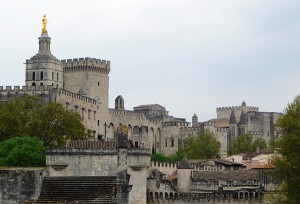Rise of the Antipopes
Given the enormous wealth and power of the Roman Catholic Church during the Middle Ages, it is not surprising that some disagreements would occasionally occur over the succession of the papacy. Whenever a substantial number of people within the church (including a large support of cardinals, not to mention sovereigns from other states) recognized a pope other than the traditional Bishop of Rome, that person has become historically known as an antipope.
The French fortified town of Avignon, just northwest of Marseille, in the 14th century played a very important role with both popes and antipopes. Here’s what happened.
With Rome increasingly unsafe and anarchic as rival families fought for control over the crumbling remnants of the old Roman empire and where even popes were no longer safe (his successor having been at one point kidnapped by political factions), Pope Clement V in 1305 moved the Roman Curia (the administration of the church) to southern France, where it within a few years settled in the loyal and heavily fortified town of Avignon.
From Pope Clement V in 1305 to Pope Gregory XI’s death in 1378, seven legitimate popes presided over the Roman Catholic Church from Avignon. From 1375 to 1378 the Papal States found themselves in open warfare with a number of Florence-led city states over disputes of territory and taxation. Pope Clement V returned to Rome in 1378 as part of an attempt to manage the quelling of this rebellion, but a difficult ship journey there ultimately led to his death a few months later.
There followed all manner of political intrigue. Amidst tremendous local pressure and rioting in Rome to elect an Roman pope after a string of French ones, the cardinals, not finding a suitable Roman candidate, elected Naples-born Pope Urban VI. Then the cardinals promptly fled Rome to avoid the wrath of the populace at having elected a non-Roman Pope. Pope Urban VI proved himself quite diplomatically ungifted, temperamental and arrogant, soon alienating both the majority of the cardinals and the King of France, who was already upset about the change from a French pope to an Italian one.
So not a few months later the same cardinals, now regretting their choice, claimed they had been pressured to elect Urban VI, renounced his legitimacy, and with the backing of the King of France elected what is now known as antipope Clement VII, an unsavory Swiss character who as cardinal during the war against Florence had personally commanded mercenary troops and authorized the slaughter of 4,000 civilians in the town of Cesena.
This created a major problem: the same group of cardinals had elected two different popes, each claiming legitimacy. And politically, half the European states supported one pope and the other half the other. This marked the beginning of what is known as the Western Schism, with concurring popes and cardinals in both Rome and Avignon.
Both popes died a few years later, each with their own successors. Force and diplomacy were attempted to try to reconcile the schism (with France even urging at one point for the Avignon pope to step down, and with the cardinals in Rome electing their pope with the express understanding that he would step down if the Avignon one also did), with unsuccessful results. In 1409 the cardinals arranged a council in Pisa to attempt to resolve the issue by having both popes resign and electing a new one. At the last minute both popes refused, each fearing treachery by the other side, and the cardinals elected another antipope, who died less than a year later and was succeeded by antipope John XXIII (if you’re counting, this now made for 3 simultaneous claimants to the papal office: the pope in Rome, the one in Avignon who was essentially stripped of his powers but refused to give up his claim, and the successor of the one elected in Pisa).
Finally, resolution came at the Council of Constance in 1414, 36 years later after the Western Schism began. Antipope John XXII (Pisa successor) agreed to step down, as did Roman pope Gregory XII after excommunicating the unsupported Avignon pope and calling for a new papal election. The cardinals elected Pope Martin V and the schism officially ended, with legitimacy conferred onto the papal succession that had previously taken place in Rome.
And thus ended Avignon’s central role in the Roman Catholic papacy: from a city that protected the Roman Curia for 73 years to a rival to the papal throne for the following 36. And now, a pretty, historical city famous for its wonderfully scented crops of lavender.

 Click to subscribe via RSS feed
Click to subscribe via RSS feed

Great article! I wasn’t aware that there was a previous pope named John XXIII (responsible for opening the Vatican II council), had to do some research about it.
http://www.newadvent.org/cathen/12272b.htm
Wikipedia says:
“He should not be confused with Pope John XXIII of the twentieth century. The fact that there were a number of Popes named John during the first 1400 years of the Church and then no more for over 500 years is probably due to the controversial figure this Antipope represented. When Angelo Cardinal Roncalli was elected and became Pope John, there was some confusion as to whether he would be John XXIII or John XXIV; he then declared that he was John XXIII to put this question to rest. The decision of the twentieth century Pope John XXIII not to be named John XXIV as might be expected serves as a confirmation of the antipope status of this first John XXIII. It should be noted, however, that the numbering of the Popes called John is debatable (as there was no John XX); for example, Gibbon refers to the Antipope John as John XXII.”